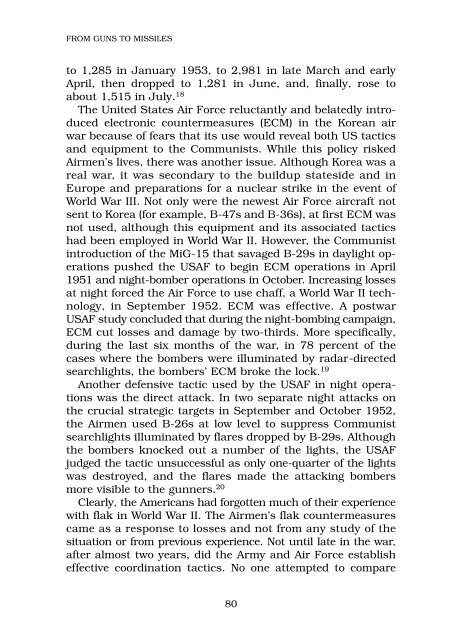Archie to SAM: A Short Operational History of Ground-Based Air ...
Archie to SAM: A Short Operational History of Ground-Based Air ...
Archie to SAM: A Short Operational History of Ground-Based Air ...
You also want an ePaper? Increase the reach of your titles
YUMPU automatically turns print PDFs into web optimized ePapers that Google loves.
FROM GUNS TO MISSILES<br />
<strong>to</strong> 1,285 in January 1953, <strong>to</strong> 2,981 in late March and early<br />
April, then dropped <strong>to</strong> 1,281 in June, and, finally, rose <strong>to</strong><br />
about 1,515 in July. 18<br />
The United States <strong>Air</strong> Force reluctantly and belatedly introduced<br />
electronic countermeasures (ECM) in the Korean air<br />
war because <strong>of</strong> fears that its use would reveal both US tactics<br />
and equipment <strong>to</strong> the Communists. While this policy risked<br />
<strong>Air</strong>men’s lives, there was another issue. Although Korea was a<br />
real war, it was secondary <strong>to</strong> the buildup stateside and in<br />
Europe and preparations for a nuclear strike in the event <strong>of</strong><br />
World War III. Not only were the newest <strong>Air</strong> Force aircraft not<br />
sent <strong>to</strong> Korea (for example, B-47s and B-36s), at first ECM was<br />
not used, although this equipment and its associated tactics<br />
had been employed in World War II. However, the Communist<br />
introduction <strong>of</strong> the MiG-15 that savaged B-29s in daylight operations<br />
pushed the USAF <strong>to</strong> begin ECM operations in April<br />
1951 and night-bomber operations in Oc<strong>to</strong>ber. Increasing losses<br />
at night forced the <strong>Air</strong> Force <strong>to</strong> use chaff, a World War II technology,<br />
in September 1952. ECM was effective. A postwar<br />
USAF study concluded that during the night-bombing campaign,<br />
ECM cut losses and damage by two-thirds. More specifically,<br />
during the last six months <strong>of</strong> the war, in 78 percent <strong>of</strong> the<br />
cases where the bombers were illuminated by radar-directed<br />
searchlights, the bombers’ ECM broke the lock. 19<br />
Another defensive tactic used by the USAF in night operations<br />
was the direct attack. In two separate night attacks on<br />
the crucial strategic targets in September and Oc<strong>to</strong>ber 1952,<br />
the <strong>Air</strong>men used B-26s at low level <strong>to</strong> suppress Communist<br />
searchlights illuminated by flares dropped by B-29s. Although<br />
the bombers knocked out a number <strong>of</strong> the lights, the USAF<br />
judged the tactic unsuccessful as only one-quarter <strong>of</strong> the lights<br />
was destroyed, and the flares made the attacking bombers<br />
more visible <strong>to</strong> the gunners. 20<br />
Clearly, the Americans had forgotten much <strong>of</strong> their experience<br />
with flak in World War II. The <strong>Air</strong>men’s flak countermeasures<br />
came as a response <strong>to</strong> losses and not from any study <strong>of</strong> the<br />
situation or from previous experience. Not until late in the war,<br />
after almost two years, did the Army and <strong>Air</strong> Force establish<br />
effective coordination tactics. No one attempted <strong>to</strong> compare<br />
80
















